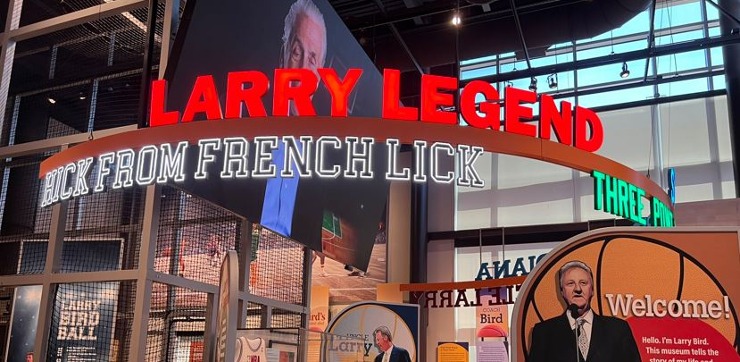NBA
Larry Bird Museum Opens Inside Terre Haute Convention Center

The Larry Bird Museum officially opened Thursday inside the Terre Haute Convention Center at Indiana State University to honor NBA Hall of Famer and Boston Celtics legend Larry Bird.
Larry Bird played three seasons at Indiana State, 13 years in the NBA with the Boston Celtics
Bird, 67, was in attendance to address the public ceremony. The 12-time NBA All-Star played for the Sycamores from 1976-79. He was a two-time consensus first-team All-American (1978, 1979) and two-time MVC Player of the Year (1978, 1979).
“It's because of the love and respect I've had for my fans and the love and respect they've shown me back,” Bird said, when he touched on why he never gets tired of interacting with fans.
“I got a little street named after me, I got a statue out there and now a museum here,” Bird said of the city, the home of Indiana State. “Thank you, Terre Haute, but I think that's enough for a while. You have no idea how much I respect the city and the people in it.”
Larry Legend back in Terredise for the opening of the Larry Bird Museum!#MarchOn pic.twitter.com/9SfCGV2Ngp
— Indiana State Basketball (@IndStBasketball) May 30, 2024
The ceremony was held a few days after the Celtics advanced to the NBA Finals, with their sweep of the Indiana Pacers in the Eastern Conference finals. Bird, a former head coach and executive with the Pacers, returned to his home-state team as a consultant in 2023.
“I remember at the All-Star Game, I told one of the Celtics owners that I thought they had the best team in the league,” said Bird, who won three NBA championships (1981, 1984, 1986) with the Celtics.
“I'm very proud of the Indiana Pacers. I think they've got a very good opportunity to keep moving on and doing very well. [Tyrese] Haliburton and other guys play well together.
“When the ball's moving, they win. If they guard a little bit, they win. Sometimes they don't guard. They have a very good team and they'll only grow together and get better.”
The Larry Bird Museum contains memorabilia from his high school, college, and NBA career
The Larry Bird Museum contains memorabilia from Bird's high school, college, and NBA career, along with interactive exhibits and interviews with coaches, teammates, and rivals.
“I think they got enough in there to keep everyone's interest,” said Bird, who helped lead Indiana State to the 1979 NCAA championship game before losing to Magic Johnson-led Michigan State. “I think it's going to be good for the city and a lot of people will come through it.”
The one special perk that Bird insisted on is free admission to the museum, according to Capital Improvement Board Museum Co-Chair Terri Conley.
@WFIUWTIUNews Just left the Larry Bird Museum opening event in Terre Haute! Full story coming soon: pic.twitter.com/KLYw6KWLHj
— Clayton Baumgarth (@theclaygerbaum) May 30, 2024
Bird wants everyone to come visit his museum. The two-time NBA Finals MVP (1984, 1986) is still in awe over the project, and Bird said he appreciates fan feedback on social media.
“I think that's what social media is all about, thank God they didn't have that when I was playing,” he said. “There are so many young kids wearing my jersey. ... Terre Haute has followed my career. You don't make these journeys alone. Terre Haute always had my back.”
More importantly, Bird never could have imagined having a museum named after him.
“All I tried to do was follow my brother's footsteps and make the varsity team,” he said. “I made myself proud when I got to start as a junior. I kept playing and, obviously, I love the game. And I loved other sports, too, but basketball clicked for me.”
Bird was only 6-foot-1 before his sophomore year at Springs Valley High School in French Lick, Indiana
Larry Bird feels blessed to have had the basketball career that he did. Before his sophomore year at Springs Valley High School in French Lick, Indiana, Bird was only 6-foot-1 before undergoing a growth spurt.
“Thank God I grew, or I'd still be working on that garbage truck,” said Bird, referring to the job he had in French Lick after leaving Indiana University before his freshman season started and before enrolling at ISU.
“At 6-1, you don't make it to the NBA unless you are special and very quick. I even grew up at Indiana State. I went from 6-7½ to 6-9 and that really helped my game.”
Bird couldn't help but mention the back injury that plagued the final few seasons of his career. He missed 22 games in the 1990-91 season due to a compressed nerve root in his back, a condition that led to his retirement in August 1992.
“It's just unfortunate my career didn't last longer because I could have played two more years, but the injuries started mounting,” he said.
“I felt we should have won at least one more championship with the team we had.”
The Celtics were never the same team without Bird. Following his retirement, the C's suffered two first-round series losses in the '90s and did not return to the NBA Finals until 2008.
As a head coach, Larry Bird coached the Indiana Pacers to the NBA Finals in 2000 before falling short against the Los Angeles Lakers. He finished 147-67 (.687) in the regular season and 32-20 (.615) in the playoffs as Indiana's coach across three seasons (1997-00).











